Motorola Droid X: Thoroughly Reviewed
by Brian Klug on July 20, 2010 4:27 PM EST- Posted in
- Smartphones
- Motorola Droid X
- OMAP
- Mobile
Screen
The X, like the original Droid and HTC EVO, uses a traditional LCD TFT display instead of AMOLED like we’ve seen in the Nexus One and HTC Incredible. As noted earlier, the X also keeps the same FWVGA resolution as the original Droid, but increases screen size to 4.3 inches.
The result is that PPI drops from 266 on the Motorola Droid to 228 on the X. The EVO uses a more Android standard 800 x 480 WVGA resolution, but has slightly lower PPI at 217. The end result is that pixels are more visible on the EVO than the X, losing out to the original Droid. For reference the iPhone 4 comes in at 330 PPI.
One of the first things that struck me about the X’s screen was that it appeared undersaturated at first glance. To some extent, this is the result of me being used to looking at oversaturated Android elements on AMOLED devices. I’ve only spent a limited time with the EVO display, but it looks like HTC has increased saturation to make it look comparable to the HTC Incredible.
It’s more than likely that what the display looks like on the X is actually how the Android UI really looks. This could be a problem of perception for people that buy the X; even though the display itself might be more representative of what colors really look like, because it isn’t oversaturated (and thus what people are used to seeing), it might set wrong impressions about color accuracy.
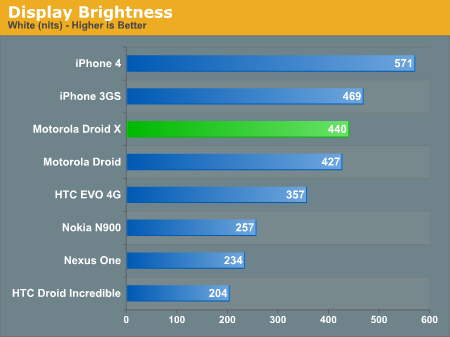
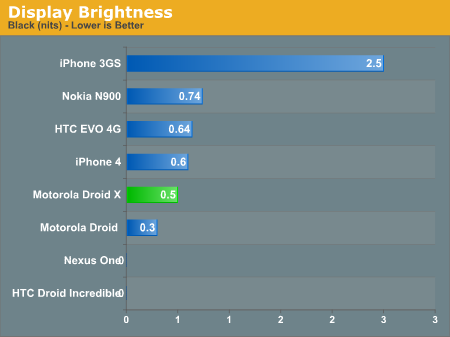
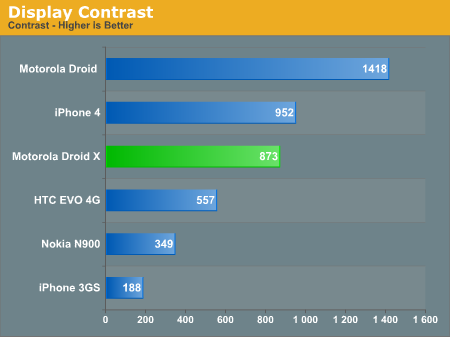
As noted before, the HTC Incredible and Nexus One displays show 0 nits of brightness on our i1D2 colorimeter, so contrast is technically nearly infinite, which is why they’re omitted from the contrast chart.
Outdoors, smartphone displays still photograph poorly and don't look great either. However, I found the X to be no less enjoyable than any other device outside if you were patient and careful to keep it in the shade.
Speakerphone
In keeping with our smartphone reviews, I measured the loudness of the X’s speakerphone using an Extech sound meter 6 inches above the display of the device. I call an automated weather report ASOS number, and wait for the call to complete. The average loudness in dBA is reported below. In all cases, ambient noise floor is a controlled 51.8 dBA.
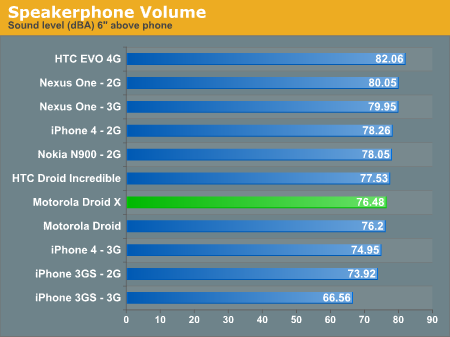
If you’ve been paying attention, you’ll notice I updated the display and speakerphone charts with data from the HTC EVO since Anand sent his my way. Here, we see the EVO 4G taking the loudness crown by a decent margin. The X’s speakerphone is decently loud, but not the absolute loudest in the pack.




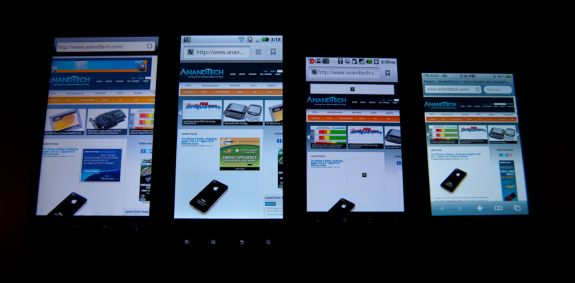
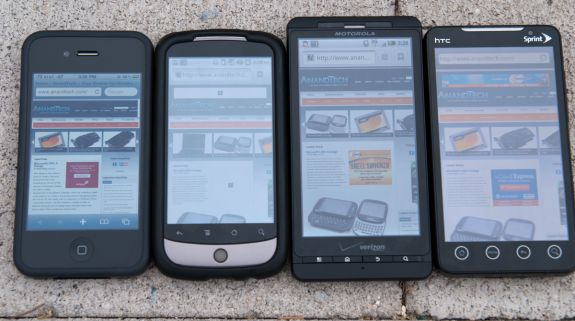














89 Comments
View All Comments
TareX - Thursday, July 22, 2010 - link
Why are all the Samsung Galaxy S phones missing from your charts and comparisons? I wanted to see how Hummingbird compared and how the Super AMOLED fared against their Droid X counterparts...strikeback03 - Tuesday, July 27, 2010 - link
Maybe because the first US version launched a day before the review went up, and they weren't sent a review sample.enealDC - Thursday, July 22, 2010 - link
Great job!Juniper Research - Friday, July 23, 2010 - link
Very interesting article... we have this week published a new report on smartphones and a free whitepaper is available to download here... http://www.juniperresearch.com/reports/next_genera...John Levett
Marketing Executive at Juniper Research
Homefries - Saturday, July 24, 2010 - link
First off, great review Brian.However, while you did a very thorough comparison of the Droid X to other Android devices, you barely mentioned the real competitor the Droid X has to stand up against: the iPhone 4.
Readers want to know if the Droid X is the best phone on the market - the whole market - not just the market subset dedicated to Android devices.
Like the majority of the tech media, your review furthers the notion readers belong exclusively to either the iOS camp or the Andriod camp. This is simply not true. Informed readers, like the ones that peruse Anandtech, want to buy one smartphone, regardless of any marketing slants, that is the best.
Your review of the Droid X should have helped us answer the question, "Should I buy the Droid X or the iPhone 4?" But, it did not.
strikeback03 - Tuesday, July 27, 2010 - link
Well, I think the conclusion in the iPhone article and some earlier Android articles applies, there is no "best" for everyone. Some people love Apple and the Apple way of life, some people won't touch it. As the iPhone is currently limited to AT&T, that is going to deter a lot of people. How large a pocket/bag you plan on carrying the phone in might make size differences more important to some than others. So while I am not one of the readers calling for no subjective opinions (it is interesting that FroYo feels significantly faster/different) I think it is still up to each buyer to decide what is most important to them.Electrofreak - Saturday, July 24, 2010 - link
Brian and Anand, are you sure you're using the correct information regarding the SoC in the Droid X? I believe it is a OMAP 3640, not a 3630, as the maximum recommended clock speed of the 3630 is described in numerous places across the net as being 720 MHz, while the max clock speed of the 3640 is described as 1 GHz. In addition, the max recommended clock speed of the 3430 in the Droid was 600 MHz, not 800.The information I cite above is widely available across the web... if you've got inside information the rest of us don't have, by all means let us know. But as someone who has written articles of my own on ARM SoCs and follows ARM industry news closely, I suspect that your data may not be 100% correct.
Regardless, I do have to thank you for writing some of the most informative hardware articles on the net. I appreciate it!
Electrofreak - Saturday, July 24, 2010 - link
...and I just found this: http://e2e.ti.com/blogs_/b/mobile_momentum/archive...So, per TI's blog it is the 3630... now we just need an explanation of the other info on the web that describes the 3630 as maxing out at 720 MHz.
Brian Klug - Monday, July 26, 2010 - link
Yeah, TI's documentation is a bit outdated. Anand tackled the SoC part, but the 3630 is indeed a 1 GHz part, it isn't the 3640 guaranteed. There was a lot of confusion online about it, but Anand got the official word. ;)I agree, back when I did my other OMAP 3 piece it was 720 MHz.
-Brian
Electrofreak - Saturday, July 24, 2010 - link
Looking forward to that Hummingbird review Brian. I hope you're able to dig up some info that I wasn't able to when I wrote my article (http://alienbabeltech.com/main/?p=17125) back in April.